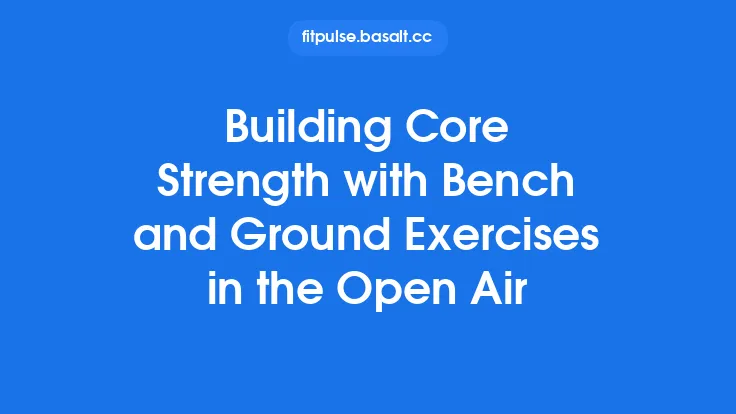A solid core is the foundation for virtually every movement you perform—whether you’re lifting a grocery bag, playing with the kids, or perfecting a yoga pose. Yet, busy schedules often leave little room for lengthy workouts. The good news is that you can achieve a noticeable boost in core strength and stability in just five minutes, using nothing but your body weight and a small amount of floor space. Below is a comprehensive, evergreen guide to a 5‑Minute Core Blast that you can slot into any part of your day, whether it’s right after you wake up, during a quick work‑from‑home break, or as the finishing touch to an evening routine.
Why a 5‑Minute Core Routine Works
Neuromuscular Activation
Short, high‑intensity bursts of core work stimulate the central nervous system, recruiting a high proportion of motor units in the abdominal and lumbar musculature. This rapid activation improves muscle firing patterns, which translates to better posture and more efficient movement in daily activities.
Time‑Based Adaptations
Research shows that even sub‑10‑minute sessions performed consistently (3–5 times per week) can lead to measurable improvements in core endurance, spinal stability, and even lower‑back pain reduction. The key is maintaining a high level of effort throughout the brief window, which forces the muscles to work near their capacity.
Metabolic Benefits
Although the core muscles are relatively small, they are highly active during stabilization tasks. Engaging them in a focused, high‑intensity routine elevates heart rate modestly, contributing to a slight afterburn effect (EPOC – excess post‑exercise oxygen consumption) that supports overall calorie expenditure.
The 5‑Minute Core Blast Structure
The routine follows a tabata‑style interval format: 40 seconds of work followed by 20 seconds of rest, repeated for five distinct exercises. This structure maximizes muscle recruitment while providing just enough recovery to maintain quality form.
| Interval | Exercise | Focus |
|---|---|---|
| 0:00‑0:40 | Dead‑Bug | Deep core activation, lumbar stability |
| 0:40‑1:00 | Rest | – |
| 1:00‑1:40 | Plank with Shoulder Tap | Anti‑rotation, shoulder stability |
| 1:40‑2:00 | Rest | – |
| 2:00‑2:40 | Bicycle Crunch | Oblique engagement, dynamic flexion |
| 2:40‑3:00 | Rest | – |
| 3:00‑3:40 | Reverse Crunch with Hip Lift | Lower‑abs focus, hip flexor control |
| 3:40‑4:00 | Rest | – |
| 4:00‑4:40 | Side Plank (30 s each side) | Lateral core, deep stabilizers |
| 4:40‑5:00 | Cool‑down stretch (optional) | – |
Each movement is chosen for its ability to target a different region of the core while requiring no equipment.
Exercise Breakdown & Technical Tips
1. Dead‑Bug (40 s)
Starting Position: Lie on your back, arms extended toward the ceiling, knees bent at 90° with shins parallel to the floor.
Execution: Slowly lower your right arm behind your head while extending the left leg straight, keeping the lower back pressed into the mat. Return to start and repeat on the opposite side.
Key Cues:
- Neutral spine: Avoid arching the lower back; engage the transverse abdominis by gently pulling the belly button toward the spine.
- Controlled tempo: Aim for a 2‑second descent and a 2‑second return to maximize time under tension.
- Breathing: Inhale as you lower, exhale as you return to start.
Progression: Add a light hold (2‑3 s) at the bottom of each rep, or perform the movement with a small resistance band around the thighs for added hip activation.
2. Plank with Shoulder Tap (40 s)
Starting Position: High plank, hands directly under shoulders, body forming a straight line from head to heels.
Execution: Lift the right hand and tap the left shoulder, then return it to the floor. Immediately repeat on the opposite side.
Key Cues:
- Hip stability: Keep hips level; avoid rocking side‑to‑side. Engage the glutes and quadriceps to maintain alignment.
- Core bracing: Imagine trying to keep a bowl of water steady on your lower back.
- Breathing: Maintain a steady breath; exhale on the tap, inhale on the return.
Progression: Perform the taps from a forearm plank to increase the challenge on the anterior core, or add a slight pause (1 s) after each tap.
3. Bicycle Crunch (40 s)
Starting Position: Supine, hands lightly behind the ears, knees lifted to tabletop.
Execution: Extend the right leg while rotating the torso to bring the left elbow toward the right knee. Switch sides in a fluid, cycling motion.
Key Cues:
- Full range of motion: Aim for the elbow to meet the opposite knee, not just a slight twist.
- Controlled speed: Prioritize quality over speed; a moderate tempo (≈1 s per phase) ensures proper muscle engagement.
- Neck safety: Keep the chin slightly tucked; avoid pulling on the neck with the hands.
Progression: Increase the tempo for a cardio boost, or hold the extended leg slightly off the ground to intensify the lower‑abs work.
4. Reverse Crunch with Hip Lift (40 s)
Starting Position: Supine, arms at sides, knees bent to 90°, feet together.
Execution: Press the lower back into the floor, lift the hips off the mat, and bring the knees toward the chest. Slowly lower back down without letting the feet touch the floor.
Key Cues:
- Pelvic control: Initiate the movement from the pelvis, not the lower back.
- Avoid momentum: Use a deliberate, slow lift (≈2 s) and a controlled descent (≈2 s).
- Breathing: Exhale on the lift, inhale on the return.
Progression: Add a small pause (1‑2 s) at the top of the movement, or perform the exercise with a slight external rotation of the hips to target the obliques.
5. Side Plank (30 s each side)
Starting Position: Lie on your side, forearm under the shoulder, knees stacked, feet together.
Execution: Lift hips to create a straight line from head to feet, holding the position. Switch sides after 30 seconds.
Key Cues:
- Alignment: Keep the head in line with the spine; avoid looking up or down.
- Engage the obliques: Imagine pulling the belly button toward the floor on the working side.
- Breathing: Maintain a steady, diaphragmatic breath throughout.
Progression: Extend the top leg for added difficulty, or perform a dynamic variation (hip dips) by lowering and raising the hips in a controlled manner.
Programming the Core Blast
Frequency
- Beginner: 3 sessions per week (e.g., Monday, Wednesday, Friday) to allow adequate recovery.
- Intermediate/Advanced: 4–5 sessions per week, possibly integrating the routine as a finisher after other workouts.
Integration with Other Workouts
- Pre‑Workout Activation: Perform the Core Blast before a strength session to prime the core for better force transfer.
- Post‑Workout Cool‑Down: Use it after cardio or full‑body circuits to reinforce spinal stability.
- Standalone Micro‑Session: Slip it into a work break or before bedtime for a quick, mind‑body reset.
Progression Strategies
- Increase Work Interval: Extend each work period by 5‑10 seconds while keeping rest proportionate.
- Add Load: Hold a light medicine ball (2–4 kg) during the Bicycle Crunch or place a weight plate on the hips for the Reverse Crunch.
- Complexity: Combine two exercises into a single flow (e.g., transition directly from Plank Shoulder Taps to Bicycle Crunch without rest) to raise cardiovascular demand.
Common Mistakes & How to Fix Them
| Mistake | Why It’s Problematic | Correction |
|---|---|---|
| Sagging hips in planks | Increases lumbar strain, reduces core engagement | Engage glutes and quads, imagine pulling the belly button toward the spine |
| Rushing the Bicycle Crunch | Turns a strength move into a cardio move, diminishing abdominal activation | Slow the tempo, focus on a full twist, keep the lower back pressed to the floor |
| Holding breath | Elevates intra‑abdominal pressure, can cause dizziness | Practice rhythmic breathing: exhale on exertion, inhale on return |
| Letting the lower back arch in Dead‑Bug | Reduces transverse abdominis activation, may cause discomfort | Keep the pelvis neutral, place a small towel under the lower back for tactile feedback |
| Touching the floor with feet in Reverse Crunch | Reduces tension on the lower abs | Keep the feet hovering a few inches above the mat throughout the set |
Benefits Beyond the Six-Pack
- Improved Posture: A strong core aligns the pelvis, reducing forward head and rounded shoulder tendencies.
- Enhanced Athletic Performance: Core stability translates to more powerful jumps, sprints, and lifts.
- Injury Prevention: By stabilizing the lumbar spine, you lower the risk of lower‑back strains during daily activities.
- Better Breathing Mechanics: Core training encourages diaphragmatic breathing, which can improve oxygen delivery and stress management.
Frequently Asked Questions
Q: Can I do this routine every day?
A: While the 5‑minute format is low‑impact, the core muscles still need recovery. For most people, 3–5 sessions per week is optimal. If you feel excessive soreness, add a rest day or replace a session with a gentle mobility flow.
Q: I have a history of lower‑back pain. Is this safe?
A: Yes, provided you maintain a neutral spine and avoid arching. Start with the Dead‑Bug and Reverse Crunch, focusing on pelvic control. If any movement causes pain, stop and consult a healthcare professional.
Q: How do I know if I’m progressing?
A: Track the number of clean repetitions per interval, or note how easily you can maintain form as you increase work time or add load. A noticeable reduction in perceived effort is also a good indicator.
Q: Do I need a mat?
A: A thin exercise mat or carpeted surface is ideal for comfort, especially for the supine and side‑plank positions. However, a firm floor works fine if you have adequate cushioning.
Q: Can I combine this with cardio?
A: Absolutely. Pair the Core Blast with a short cardio burst (e.g., 5‑minute jump rope) for a balanced, time‑efficient session.
Quick Reference Cheat Sheet
- Total Time: 5 minutes
- Equipment: None (optional mat)
- Structure: 40 s work / 20 s rest × 5 exercises
- Core Areas Targeted: Rectus abdominis, obliques, transverse abdominis, lumbar multifidus, gluteus maximus (as stabilizer)
- Progression Options: Longer work intervals, added weight, dynamic combos, increased frequency
Print this sheet, set a timer, and you’ll have a portable, evergreen core solution that fits into any schedule—no equipment, no excuses.





